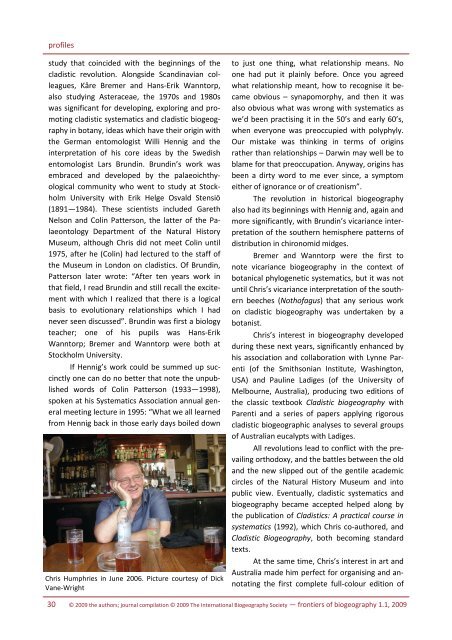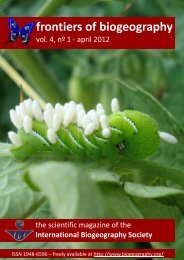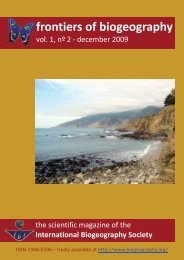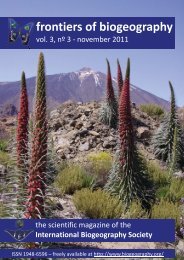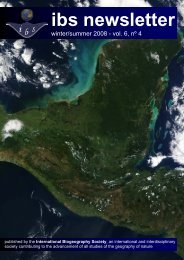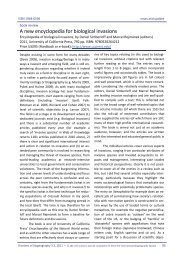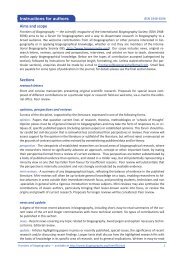entire PDF (2.6 MB) - The International Biogeography Society
entire PDF (2.6 MB) - The International Biogeography Society
entire PDF (2.6 MB) - The International Biogeography Society
- No tags were found...
Create successful ePaper yourself
Turn your PDF publications into a flip-book with our unique Google optimized e-Paper software.
profiles<br />
study that coincided with the beginnings of the<br />
cladistic revolution. Alongside Scandinavian colleagues,<br />
Kåre Bremer and Hans-Erik Wanntorp,<br />
also studying Asteraceae, the 1970s and 1980s<br />
was significant for developing, exploring and promoting<br />
cladistic systematics and cladistic biogeography<br />
in botany, ideas which have their origin with<br />
the German entomologist Willi Hennig and the<br />
interpretation of his core ideas by the Swedish<br />
entomologist Lars Brundin. Brundin’s work was<br />
embraced and developed by the palaeoichthyological<br />
community who went to study at Stockholm<br />
University with Erik Helge Osvald Stensiö<br />
(1891—1984). <strong>The</strong>se scientists included Gareth<br />
Nelson and Colin Patterson, the latter of the Palaeontology<br />
Department of the Natural History<br />
Museum, although Chris did not meet Colin until<br />
1975, after he (Colin) had lectured to the staff of<br />
the Museum in London on cladistics. Of Brundin,<br />
Patterson later wrote: “After ten years work in<br />
that field, I read Brundin and still recall the excitement<br />
with which I realized that there is a logical<br />
basis to evolutionary relationships which I had<br />
never seen discussed”. Brundin was first a biology<br />
teacher; one of his pupils was Hans-Erik<br />
Wanntorp; Bremer and Wanntorp were both at<br />
Stockholm University.<br />
If Hennig’s work could be summed up succinctly<br />
one can do no better that note the unpublished<br />
words of Colin Patterson (1933—1998),<br />
spoken at his Systematics Association annual general<br />
meeting lecture in 1995: “What we all learned<br />
from Hennig back in those early days boiled down<br />
Chris Humphries in June 2006. Picture courtesy of Dick<br />
Vane-Wright<br />
to just one thing, what relationship means. No<br />
one had put it plainly before. Once you agreed<br />
what relationship meant, how to recognise it became<br />
obvious – synapomorphy, and then it was<br />
also obvious what was wrong with systematics as<br />
we’d been practising it in the 50’s and early 60’s,<br />
when everyone was preoccupied with polyphyly.<br />
Our mistake was thinking in terms of origins<br />
rather than relationships – Darwin may well be to<br />
blame for that preoccupation. Anyway, origins has<br />
been a dirty word to me ever since, a symptom<br />
either of ignorance or of creationism”.<br />
<strong>The</strong> revolution in historical biogeography<br />
also had its beginnings with Hennig and, again and<br />
more significantly, with Brundin’s vicariance interpretation<br />
of the southern hemisphere patterns of<br />
distribution in chironomid midges.<br />
Bremer and Wanntorp were the first to<br />
note vicariance biogeography in the context of<br />
botanical phylogenetic systematics, but it was not<br />
until Chris’s vicariance interpretation of the southern<br />
beeches (Nothofagus) that any serious work<br />
on cladistic biogeography was undertaken by a<br />
botanist.<br />
Chris’s interest in biogeography developed<br />
during these next years, significantly enhanced by<br />
his association and collaboration with Lynne Parenti<br />
(of the Smithsonian Institute, Washington,<br />
USA) and Pauline Ladiges (of the University of<br />
Melbourne, Australia), producing two editions of<br />
the classic textbook Cladistic biogeography with<br />
Parenti and a series of papers applying rigorous<br />
cladistic biogeographic analyses to several groups<br />
of Australian eucalypts with Ladiges.<br />
All revolutions lead to conflict with the prevailing<br />
orthodoxy, and the battles between the old<br />
and the new slipped out of the gentile academic<br />
circles of the Natural History Museum and into<br />
public view. Eventually, cladistic systematics and<br />
biogeography became accepted helped along by<br />
the publication of Cladistics: A practical course in<br />
systematics (1992), which Chris co-authored, and<br />
Cladistic <strong>Biogeography</strong>, both becoming standard<br />
texts.<br />
At the same time, Chris’s interest in art and<br />
Australia made him perfect for organising and annotating<br />
the first complete full-colour edition of<br />
30 © 2009 the authors; journal compilation © 2009 <strong>The</strong> <strong>International</strong> <strong>Biogeography</strong> <strong>Society</strong> — frontiers of biogeography 1.1, 2009


